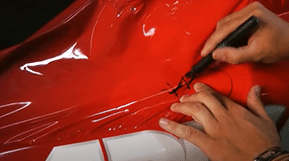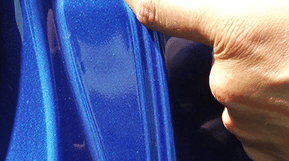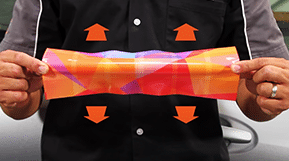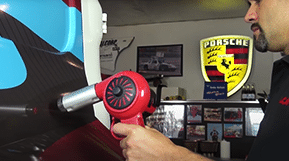Propane Torch vs Heat Gun
First, let’s look at the propane torch. The pros of using the torch are the absolute consistency in temperature output regardless of the environment of the application, the speed of which the torch reaches application temperature, and complete portability. The cons are that the torches heat is very concentrated and will instantly brown your graphic if you hold it in one place too long. It also heats a very small area.
The pros of using a heat gun are that the heat gun heats a larger area and the soft edge of the heat bloom will preheat adjacent areas, allowing you to continuously work a line of rivets. The cons are if you are installing rivets in a cooler environment the temperature output can change greatly and you will need to customize your application approach. Also, a heat gun tethers you to a wall and some heat guns will not operate well if extension cords need to reach more than a 100 feet.
For decades we applied graphics straight over the rivets, carefully poked holes either all around or just at the bottom of the tented vinyl, pushed the air out with our thumb, applied heat, and finally set the vinyl with the rivet brush. This worked well enough but if the holes remain imperfect or air was accidentally trapped in the super-heated vinyl we were left with a failure. This method was difficult to keep consistent over the thousands of rivets on the sides of each trailer.
With the wide spread use of air egress technology in most premium films, rivets have become much easier and faster to install. Arlon’s digital fleet graphics films use a unique air egress pattern that allows you to finish rivets quickly.
Rivet Application Technique
First, clean with a detergent mixture and then finish cleaning with isopropyl alcohol. Begin by installing the vinyl between the rows of rivets leaving a vent over the line of rivets that begins at the bottom of the trailer. It must continue unbroken to the top of trailer. The vent should be a consistent one inch wide at most. The top aluminum rail creates a natural horizontal vent which allows the air to escape in either direction. It is critical that this vent is unbroken from bottom to top. If the vent collapses by accident you will need to poke a hole in the vinyl to release the air. Don’t make the hole near a rivet.
Work the vinyl down around the rivet, cold. Then, finally set them with heat. This will help keep the vinyl sealed around the rivets. Then use your heat source to heat the first six rivets to about a 180 degrees Fahrenheit. Immediately roll the next three rivets quickly using firm pressure.
Continue this pattern, heat six, install three all the way up the line of rivets. The rivets will look perfect and be completely sealed. This is the quickest and most consistent way to apply rivets.
Some installers prefer to set the rivets first. The technique is the same, just in reverse. Notice how both sets of double rivets are installed, but the flat area between is not. Now, simply install this area and the application is done.
Using Rollers to Apply Rivets
Sometimes, the roller leaves a mottled texture around the rivets. A quick post-heat will bring the original gloss level back to your graphic. If the application environment has the temperature outside the suggested range of 70 degrees to 80 degrees Fahrenheit, try a few runs of rivets using different amounts of heat and roller speeds to get the perfect combination. This can literally change from day to day in some climates. Whether you purchase a proper application wheel or just use foam paint rollers bought at a hardware store, be sure the roller is firm and undamaged throughout the entire application. For some rollers this may mean that you will need to change it out several times during the application.
Both methods of rivet application are acceptable. So the decision is yours. If you can become comfortable using a roller eventually you’ll be able to install rivets three or four times faster than the old poke and brush method with a much better result.



